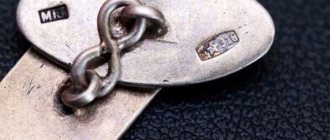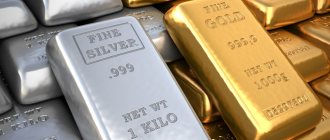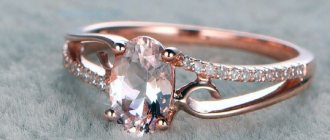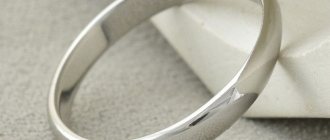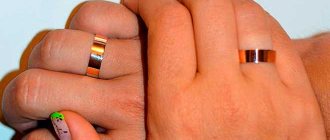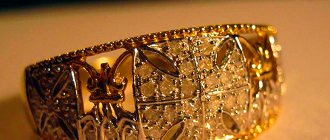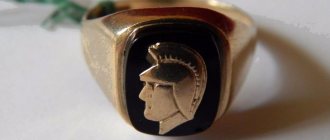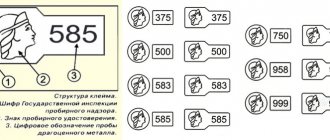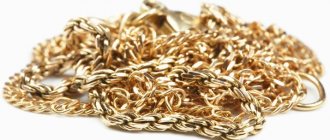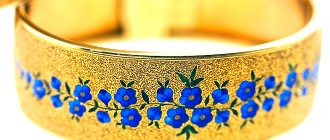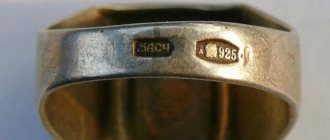Gold metal and its derivatives are popular among people all over the world. Those who want to protect their savings from depreciation invest in the eternal currency of all times and peoples. Gold has many uses depending on the alloy.
In its pure form it is not entirely attractive. It is a soft metal with a dull color, unsuitable for processing or making jewelry. To improve its chemical and aesthetic properties, other metals began to be added to the gold alloy. The result was positive: varieties of gold metal, shades appeared, and the price changed.
In order to understand what kind of gold was in the hands, samples began to be put on the products. If you look closely at any gold product, it always has a small stamp with a number. This is a test. From Latin “sample” means evaluation, test. In other words, the sample shows the ratio of gold in the product in relation to other metals. A sample is placed on the product to confirm the presence of the specified amount of gold in it.
Noble metal silver. The concept of a sample. Why is silver diluted with ligatures?
Silver is a malleable and fusible element that is part of the group of precious metals. This group includes gold, platinum, and five other platinum-class metals.
Lunar metal is considered a symbol of purity, is a universal material for creating amulets and religious paraphernalia, and has unique bactericidal properties.
Silver is a soft material, so it is not used “pure” in jewelry. The precious metal is alloyed with various impurities, which change the final characteristics of the entire alloy. Such additives are called ligatures. Their addition can change the color of the alloy, increase hardness, wear resistance, and improve casting properties.
Most often, silver is alloyed with copper, zinc, cadmium, nickel, and less often with platinum and gold.
The sample of a precious metal reports the amount of noble material in relation to the entire composition of the product. For example, if a silver ring is marked “925,” it means that 92.5% of the entire piece of jewelry is pure silver, with the remainder being various impurities.
Recommendations for care, cleaning and storage
Moon metal should be stored in a dry and dark place. Wear it more often. If the jewelry sits for a long time, it will fade faster. There is no need to dump all the items in one pile, as they will damage each other.
The main enemies of silver are:
- increased humidity and temperature;
- substances containing sulfur;
- paper or cardboard containers.
Jewelry needs to be cleaned periodically. There are several methods:
- Dilute ammonia with water in a ratio of 1:10. Place the silver in the solution for 15 minutes. Then remove and rinse in clean water, and finally wipe with a soft cloth;
- pour 50 g of soda into 1 liter of water and throw in a piece of foil. Place the products in the solution and boil them. Then rinse and dry;
- Pour 100 g of citric acid into 500 ml of water. Immerse the decorations and boil them for 20–30 minutes. Then rinse and dry;
- buy Johnson “Silver Quick” or Leuchtturm liquids in jewelry stores. Immerse the silver in them for a few minutes, then rinse and wipe.
If the jewelry has inlay, then such methods can harm it. In this case, it is better to contact jewelers.
Mysterious sample 975
What does 975 silver or gold mean if global standards do not include such a concept?
Most likely, the 975 marking on lunar metal is nothing more than 925 silver. The number 7 may have been poorly printed or erased over time. This is especially true for antique products. It is likely that over many years the second number on the surface of the decoration simply acquired a resemblance to a seven.
The situation is similar with 875 precious metal. On antique items it is easy to confuse the numbers 8 and 9.
As for gold, the metric value of 375 can be taken as the number 975.
Russian GOST includes the following gold alloys: Z75, 500, 58Z, 585, 750, 916, 958, 999. Therefore, if the seller assures you that the jewelry is genuine 975 gold, you can be sure that this is a fake.
You can check the authenticity of the precious metal yourself. Try dropping iodine onto an inconspicuous part of the product. Real silver will quickly darken. The formation of plaque or the complete absence of any reaction will indicate a fake.
Contact with iodine also darkens the solar metal. Lightening the stain is only possible on fake products.
Iodine for checking the authenticity of silver
Standard Sheet Metal Sizes
- Blog
- Download Resources
- Briefcase
- Career
- Contact us
- Request a price
- Services Pipe production
- Pipe bending and pipe manufacturing
- Metal parts and components
- Roll forming equipment
- Sheet metal production
- Laser cutting
- Welding robot
- Shot blasting
- Powder coating
- Rolling ring
.Standard Sheet Metal Thickness Chart
- House
- The educational center
- Articles
- Sheet metal gauge
BY: CableOrganizer.com
Sheet metal thickness (sometimes referred to as "gauge") indicates the standard thickness of sheet metal for a particular material. As gauge increases, the thickness of the material decreases.
Sheet metal thickness gauges for steel are based on a weight of 41.82 pounds per square foot per inch of thickness. This is known as the manufacturers standard gauge for sheet steel. For other materials such as aluminum and brass, the thickness will be different. Thus, a 10-gauge steel plate that is 0.1345 inches thick would weigh 41.82 * 0.1345 = 5.625 pounds per square foot.
Examples: 16 ga CRS equals 2.5 psi. For the 18g CRS the weight is 2.0 psi and for the 20g CRS it is 1.5 psi.
0,128
| Caliber | Steel | Carbon steel eh | Cink Steel | Stainless steel | Aluminum | Steel (mm) | |||||||
| 07 | 0,179 | — | — | — | — | 4,547 | |||||||
| 08 | 0.165 | 0,1644 | 0,1681 | 0,1719 | 0,1285 | 4,191 | |||||||
| 09 | 0,150 | 0,1495 | 0,1532 | 0,1563 | 0,1144 | 3,810 | |||||||
| 10 | 0,1382 | 0,1406 | 0,1019 | 3,429 | |||||||||
| 11 | 0,120 | 0,1196 | 0,1233 | 0.1250 | 0,0907 | 3,048 | |||||||
| 12 | 0,105 | 0,1046 | 0,1084 | 0,1094 | 0,0808 | 2,677 | |||||||
| 13 | 0,09 | — | — | 0,09 | 2,286 | ||||||||
| 14 | 0,075 | 0,0747 | 0,0785 | 0,0781 | 0,0641 | 1,905 | |||||||
| 15 | 0.067 | — | — | 0,07 | 0,057 | 1,702 | |||||||
| 16 | 0,060 | 0,0598 | 0,0635 | 0,0625 | 0,0508 | 1,524 | |||||||
| 17 | — 0,054 | — | 0,056 | 0,045 | 1,372 | ||||||||
| 18 | 0,047 | 0,0478 | 0,0516 | 0,0500 | 0,0403 | 1.1938 | |||||||
| 19 | 0,042 | — | — | 0,044 | 0,036 | 1,067 | |||||||
| 20 | 0,036 | 0,0359 | 0,0396 | 0,0375 | 0,0320 | 0,91427 | 21 | 0,033 | — | — | 0,034 | 0,028 | 0,838 |
| 22 | 0,03 | — | — | 0.031 | 0,025 | 0,762 | |||||||
| 23 | 0,027 | — | — | 0,028 | 0,023 | 0,686 | |||||||
| 24 | 0,024 | — | — | 0,025 | 0,02 | 0,61 | |||||||
| 25 | 0,021 | — | — | 0,022 | 0,018 | 0,533 | |||||||
| 26 | 0,018 | — | — | 0.019 | 0,017 | 0,457 | |||||||
| 27 | 0,016 | — | — | 0,017 | 0,014 | 0,406 | |||||||
| 28 | 0,015 | — | — | 0,016 | — | 0,381 | |||||||
| 29 | 0,014 | — | — | 0,014 | — | 0,356 | |||||||
| 30 | 0,012 | — | — | 0.013 | — | 0,305 | |||||||
| 31 | — | — | — | 0,011 | — | — |
- Thickness is expressed in inches, except for the millimeter column (1 inch = 25.4 mm).
- This chart is for reference only and it is strongly recommended that you check with your local supplier to determine the actual thicknesses used in your specific location.
© 2021 CableOrganizer.com, LLC. Reproduction of this article in part or in whole without the written permission of CableOrganizer.com is prohibited.
.
What does the mark look like?
The stamp on silver should look like this: first, the state inspection code is placed, then the mark of the assay certificate, and then the digital designation of the sample.
The state inspection code indicates the territory where the product was branded.
The mark of the assay certificate on the territory of Russia looks like an imprint of the profile of a woman in a kokoshnik. If in front of you is a product from the times of the USSR, then the sign will look like a five-pointed star or a worker’s head.
All alloys containing at least 30% precious metal are subject to branding.
All information about a product made of lunar metal must be inscribed in a figure shaped like a barrel. Information about gold products is inscribed in a figure resembling a spatula.
Application technologies
Modern jewelry manufacturers use one of three methods of applying stamps. Which technology will be used depends on various factors, the determining ones being the type of jewelry and the precious metal used. The most high-grade jewelry is very soft and fragile, so mechanical processing is not always suitable for them. The main methods of branding are:
- shock-mechanical;
- laser;
- electroerosive.
The mechanical impact method involves physical impact on the metal in order to obtain the desired impression. Stamps are applied with hammers or on special machines designed for mass production. Mechanical application was first used in the 17th century and remains the most popular technology in our time. Almost 85% of all manufactured gold products are branded using this method. The tags are durable and easily visible. Anvils of different shapes and sizes allow you to obtain the desired images with little risk of metal deformation.
Electroerosion technology involves burning out prints with a spark. The markings also appear clear and durable. This method is preferred when you need to apply meaning and image to particularly fragile jewelry. But when using electrical discharge machining, it is important that the surface is perfectly polished, without casting defects or the slightest roughness. The technology was first applied and mastered in 1967, so it is considered relatively young.
The laser method is an innovative branding method made possible by the development of high-precision laser equipment. It allows you to print minimally sized images that can be clearly read when using special magnifying devices. The laser can make up to 600 impressions in 1 work shift.
The surface of the product must be pre-polished and cleaned, because after branding it is impossible to grind and polish the metal. With the help of modern installations, it is possible to print even on hollow products, and the main advantage is the ability to place the image on both the concave and convex sides.
Table: popular silver samples, their use
The provided digital designations for silver samples according to Russian GOST: 800, 830, 875, 925, 960, 999.
Depending on the purity of the alloy, lunar metal is used to create a wide variety of objects. Let's look at the most popular samples in the table below.
| Marking | Amount of silver, g | Amount of copper, g | Production |
| 800 | 800 | 200 | A durable alloy from which tableware, writing utensils, and decorative items are made. |
| 830 | 830 | 170 | It is used for making household items, figurines, cigarette cases, and dishes. |
| 875 | 875 | 125 | It is used in the jewelry industry, as well as in the creation of kitchen utensils and decorative elements. |
| 925 | 925 | 75 | It is mainly used in the production of jewelry, coinage, and memorial signs. |
| 960 | 960 | 40 | Used to create filigree jewelry and luxury items. |
Advantages and disadvantages
The advantages of the 875th sample include low cost. Using rhodium plating and plating, stylish, beautiful jewelry is obtained. You can flaunt such jewelry at banquets and social events. Low tendency to oxidation, blackening, strength are the positive aspects of the material.
Insufficient ductility and difficulty in processing are the weak points of 875 silver. It is more difficult to create elegant crafts from 875 standard than from sterling. Excessive hardness interferes with fine processing, so 875 silver is more often used in industrial jewelry production.
Table: gold hallmarks popular in the jewelry world
To find out how much gold is in the most popular alloys, you can use the table:
| Metric system | 999 | 958 | 750 | 585 | 583 | 500 | 375 |
| Carat system | 24K | 23K | 18K | 14K | 14K | 12K | 9K |
| Amount of pure precious metal | 99,9% | 95,8% | 75% | 58,5% | 58,3% | 50% | 37,5% |
Testing systems.
There are several systems for sample determination:
- Metric. Here the volume of noble metal in 1 gram of alloy is taken as a basis. The value can also be estimated as the number of parts of metal per 1000 parts of alloy. For example, in an alloy of 750 standard there are 750 parts of noble metal and 250 parts of the rest. In Russia, the metric system has been used since 1927. It is also used in France, Germany, Great Britain, Cyprus, Lithuania, Norway, etc. For some time, Soviet jewelers made products from 583 standard, but after the collapse of the USSR it was replaced by 585 in order to equalize the quality of Soviet and Western products.
- Carat system. Applicable in Canada and USA. In Ireland, metric and carat stamps are still placed on products. Pure metal has a value of 24 carats. 1 carat contains 1/24 of the main mass of gold. A 14 carat alloy has 14 parts precious and 10 parts other metal. In their work, Western jewelers use 24,14,18,10,9 carat alloys. To indicate the carat standard, the abbreviations K, ct, k are used. To convert carat to metric, you need to divide the carat value by 24 and multiply by 1000.
- The spool test was used in Russia until 1927. It differed from carat in that the highest standard had 96 units of metal. To convert this sample to carat, you need to divide its value by 4. To convert it to metric, you need to divide by 96 and multiply by 1000.
Where can you buy jewelry from 975 standard
Jewelry with such markings cannot be found even in private workshops. It is possible that this alloy can be made to order by a professional jeweler, but then the question arises about the feasibility of such a request.
On the Internet you can come across many advertisements for the sale of various 975 class products. Such advertisements are placed by scammers or people who accidentally made a mistake.
If a jewelry boutique tries to sell you a product with this marking, feel free to ask the seller for a certificate of conformity.
Often they try to sell jewelry with the 975 mark secondhand. This is where the highest risk of encountering a fake is.
Silver rings with precious stones
Etymology
There are several versions of the origin of the name. Some sources[1] believe that the name appeared in the 12th century and was originally the name of an ancient English silver coin. 240 coins weighed 1 pound (453.6 grams). Large purchases were expressed in “pounds sterling.” On the other hand, it was a way to check the weight of the coins - if the weight of 240 coins was not equal to 1 pound, the coins could be counterfeit or too worn.
In 1955, the Oxford English Dictionary suggested that the name sterling dates back to around 1300 and comes from the common name for a silver Norman penny that had small stars on it (Old English: steorling).
The most widely accepted theory is that of Walter de Pinchebek, which states that the name "Easterling Silver" was previously used to refer to the characteristic alloy of 925 silver from which coins were made in northern Germany. This area of five cities was called “Easterling” by the British; in the 12th century it became part of the Hanseatic League (Hanse). This district had its own representative office (“office”) in London and conducted active trade with England, paying for goods with local coins that were of high quality and hardness (pure silver is too soft and wears off quickly). King Henry II made this alloy the standard for English coins starting in 1158. Gradually in speech the name of the alloy was shortened to “Sterling Silver” and became the equivalent of “coin silver”.
Section question - answer
Is 975 silver good or not?
Expert opinion
Pribrezhny Gennady Valentinovich
Jeweler 6th category
It is impossible to judge whether the 975 marking is good or bad, since, alas, it does not exist. It is often mistaken for grade 375 gold or grade 875 and 925 lunar metal. These alloys have individual advantages, thanks to which they were able to become generally recognized.
How to find out if 925 sample is fake or not?
Expert opinion
Grishanov Mikhail Petrovich
Jeweler, director of the Grishanov and Co. workshop
The best solution would be to visit a jewelry workshop or pawnshop. You are most likely misreading the stigma, which may have become blurred over time.
Simple English Wikipedia, the free encyclopedia
Some chemical elements are called metals
. They are the majority of the elements in the periodic table. These elements usually have the following properties:
- They can conduct electricity and heat.
- They are easy to form.
- They look shiny.
- They have a high melting point.
Most metals remain solid at room temperature, but this is not necessary. Mercury is liquid. Alloys are mixtures in which at least one part of the mixture is a metal. Examples of metals: aluminum, copper, iron, tin, gold, lead, silver, titanium, uranium and zinc. Well-known alloys include bronze and steel.
The study of metals is called metallurgy.
Signs of similarity between metals (properties of metals) [edit | change source]
Most metals are hard, shiny, feel heavy, and only melt at very high temperatures. Pieces of metal make a bell-like sound when struck by something heavy (they are ringing). Heat and electricity can easily pass through metal (it is conductive). A piece of metal can be broken into a thin sheet (it is malleable) or stretched into a thin wire (it is ductile). Metal is difficult to tear (it has high tensile strength) or break (it has high compressive strength). If you press on a long, thin piece of metal, it will bend rather than break (it's elastic). With the exception of cesium, copper and gold, the metals are neutral silver in color.
Not all metals have these properties. Mercury, for example, is liquid at room temperature, lead is very soft, and heat and electricity do not travel through iron as well as copper.
The bridge in Russia is metal, probably iron or steel.
Metals are very useful to people. They are used to make tools because they can be durable and easy to work with. Iron and steel were used to build bridges, buildings or ships.
Some metals are used to make items such as coins because they are hard and do not wear out quickly. Examples include copper (shiny and red), aluminum (shiny and white), gold (yellow and shiny), and silver and nickel ( also white and shiny).
Some metals, such as steel, can be made sharp and remain sharp, so they can be used to make knives, axes, or razors.
Rare metals with high value such as gold, silver and platinum are often used to make jewelry. Metals are also used to make fasteners and screws. Pots used for cooking can be made of copper, aluminum, steel or iron. Lead is very heavy and dense and can be used as ballast on boats to prevent them from capsizing or to protect people from ionizing radiation.
Many items made from metals can actually be made from mixtures of at least one metal with other metals or with non-metals. These mixtures are called alloys. Some common alloys:
Humans first began making things from metal over 9,000 years ago when they discovered how to extract copper from [the] ore. Then they learned to make a harder alloy - bronze, by adding tin to it. About 3000 years ago they discovered iron. By adding small amounts of carbon to iron, they discovered that it could produce a particularly useful alloy: steel.
In chemistry, metal is a word that refers to a group of chemical elements that have certain properties. Metal atoms easily lose an electron and become positive ions or cations. Thus, metals are not like the other two types of elements - nonmetals and metalloids. Most elements of the periodic table are metals.
In the periodic table, we can draw a zigzag line from the element boron (symbol B) to the element polonium (symbol Po). The elements through which this line passes are metalloids. The elements located above and to the right of this line are non-metals. The remaining elements are metals.
Most of the properties of metals are due to the fact that the atoms in the metal do not hold their electrons very tightly. Each atom is separated from the others by a thin layer of valence electrons.
However, some metals are different. An example is sodium metal. It is soft, melts at a low temperature and is so light that it floats on water. However, people should not try this because another property of sodium is that it explodes when it comes in contact with water.
Most metals are chemically stable and do not react easily, but some do. Alkali metals such as sodium (symbol Na) and alkaline earth metals such as calcium (symbol Ca) are reactive. When metals do react, they often react with oxygen. Metal oxides are basic. Non-metal oxides are acidic.
Compounds, in which metal atoms are joined to other atoms to form molecules, are probably the most common substances on Earth. For example, table salt is a sodium compound.
A piece of pure copper found as native copper
The use of metals is believed to differentiate humans from animals. Before using metals, people made tools from stone, wood, and animal bones. Now this is called the Stone Age.
No one knows when the first metal was found and used. It was probably the so-called native copper, which is sometimes found in large pieces on the ground. People have learned to make copper tools and other things from it, although it is quite soft for a metal. They learned smelting to extract copper from common ores. When copper was smelted over fire, people learned to make an alloy called bronze, which is much harder and stronger than copper. Knives and weapons were made from bronze. This is the time in human history after about 3300 BC. often called the Bronze Age, that is, the time of bronze tools and weapons.
Around 1200 BC, some people learned to make iron tools and weapons. They were even harder and stronger than bronze, and this was an advantage in war. The time of iron tools and weapons is now called the Iron Age. . Metals have been very important in the history of mankind and civilization. Iron and steel played an important role in the creation of machines. Gold and silver were used as money so that people could trade, that is, exchange goods and services over long distances.
In astronomy, a metal is any element other than hydrogen or helium. This is because these two elements (and sometimes lithium) are the only ones that are formed outside of stars. In the sky, a spectrometer can see the signatures of metals and show the astronomer the metals in a star.
In the human body, some metals are essential nutrients, such as iron, cobalt and zinc. Some metals may be harmless, such as ruthenium, silver and indium. Some metals can be toxic in large quantities. Other metals, such as cadmium, mercury, and lead, are highly toxic. Sources of metal poisoning include mining, tailings ponds, industrial waste, agricultural runoff, occupational exposure, paints, and treated wood.
.
Reviews
From my great-grandmother I inherited a gold wedding ring from the times of the Russian Empire, weighing almost 10 grams. The engraving on it says 950, which I've never even heard of. And the color was questionable, an unnatural bright yellow. I thought the ring was made of some kind of copper alloy until I showed it to the jeweler. It can be seen that the metal is soft, the ring has multiple damages, but not a single pawnshop accepts such a product.
Oleg Sh. Dnepropetrovsk
Milena R., Stavropol
I once heard about dishes from past centuries with handles made of different materials, but I didn’t believe it until I saw it myself. A collector I know bought an unusual silver service. The inside of the container is gold and the handles are wooden. There is an engraving with the name of the master and a stamp with hallmark. The set was made in Paris from 950 silver, and it costs incredibly a lot of money, but in appearance it doesn’t stand out in anything special.
I only encountered the 950 sample when I was choosing a gift for my wife. It turns out that platinum is also expensive. Its advantage is considered to be the minimum content of impurities in the alloy, which means it will not oxidize and darken. Its steely white finish will remain that way forever. In addition, many platinum jewelry are exclusive due to the rarity of the metal and its high cost.
Vasily Petrov, Moscow
